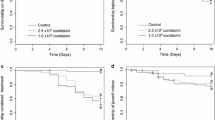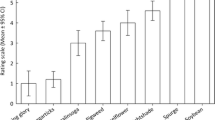Abstract
Bemisia tabaci Genn. (Hemiptera: Aleyrodidae) and Frankliniella occidentalis (Thysanoptera: Thripidae) are major pests in greenhouse grown cucumber crops. Recently, Amblyseius swirskii Athias-Henriot (Acari: Phytoseiidae) was shown an effective biological control agent of both pests. Hence, perhaps both pests can be controlled simultaneously by this predator. However, with simultaneous infestation of both pests, synergistic effects, or interference could affect biological control and perhaps require changes in release rates of the predator. Thus, the aim of the present study was to evaluate different release rates of A. swirskii to control both pests under a worst case scenario of rapid immigration into a cucumber greenhouse. Two experiments were conducted, one simulating the influx of whiteflies alone (whitefly experiment) and the other immigration of whiteflies and thrips together (whitefly plus thrips experiment). Three treatments were compared in the whitefly experiment: (1) B. tabaci alone, (2) B. tabaci + 25 A. swirskii m−2 and (3) B. tabaci + 75 A. swirskii m−2. The high release rate was more effective than the low rate in controlling B. tabaci alone. The high rate was subsequently tested against B. tabaci and F. occidentalis for the whitefly and thrips experiment in which five treatments were compared: (1) B. tabaci alone, (2) F. occidentalis alone, (3) B. tabaci + 75 A. swirskii m−2, (4) F. occidentalis + 75 A. swirskii m−2 and (5) B. tabaci + F. occidentalis + 75 A. swirskii m−2. This rate of A. swirskii controlled whiteflies and thrips either alone or together. Therefore, 75 A. swirskii m−2 should be an adequate rate for controlling both pests either alone or simultaneously in cucumber greenhouses.





Similar content being viewed by others
References
Abbott WA (1925) A method to computing the effectiveness of an insecticide. J Econ Entomol 18:265–267
Belda JE, Calvo J (2006) Eficacia de Amblyseius swirskii Athias-Henriot (Acari: Phytoseiidae) en el control biológico de Bemisia tabaci (Genn.) (Hom.: Aleyrodidae) y Frankliniella occidentalis (Pergande) (Thys.: Thripidae) en pimiento en condiciones de semicampo. Bol San Veg Plagas 32:283–296
Calvo FJ, Bolckmans K, Belda JE (2009) Development of a biological control-based IPM method for Bemisia tabaci for protected sweet pepper crops. Entomol Exp Appl 133:9–18
Collier T, van Steenwyk R (2004) A critical evaluation of augmentative biological control. Biol Control 31:245–256
Crawley MJ (2002) Statistical computing. An introduction to data analysis using S-Plus. Wiley and Sons Press, Chichester
Crowder D (2006) Impact of release rates on the effectiveness of augmentative biological control agents. J Insect Sci 7:1–11
DeBach P, Rosen D (1991) Biological control by natural enemies. Cambridge University Press, Cambridge
El-Laithy AYM, Fouly AH (1992) Life table parameters of the two phytoseiid predators Amblyseius scutalis (Athias-Henriot) and A. swirskii Athias-Henriot. J Appl Entomol 113:8–12
Espinosa PJ, Fuentes JF, Contreras J, Bielza P, Lacasa A (2002) Método de cría en masa de Frankliniella occidentalis (Pergande). Bol San Veg Plagas 28:385–390
González Zamora JE, Gallardo JM (1999) Desarrollo y capacidad reproductiva de Bemisia tabaci (Gennadius) (Homoptera; Aleyrodidae) en pimiento a tres temperaturas. Bol San Veg Plagas 25:3–11
Hoda FM, El-Naggar ME, Taha AH, Ibrahim GA (1986) Effect of different types of food on fecundity of predaceous mite Amblyseius swirskii Athias-Henriot (Acari: Phytoseiidae). Bull Soc Entomol Egypt 66:113–116
Huffaker CB, Messenger PS (1976) Theory and practice of biological control. Academic Press, New York
Messelink GJ, van Steenpaal SEF, Ramakers PMJ (2006) Evaluation of phytoseiid predators for control of western flower thrips on greenhouse cucumber. BioControl 51:753–768
Messelink GJ, van Maanen R, van Steenpaal SEF, Janssen A (2008) Biological control of thrips and whiteflies by a shared predator: two pests are better than one. Biol Control 44:372–379
Momen FM, El-Saway SA (1993) Biology and feeding behavior of the predatory mite Amblyseius swirskii (Acari: phytoseiidae). Acarologia 34:199–204
Myers J, Charlene H, Kovacs E (1989) How many insect species are necessary for the biological control of insects? Environ Entomol 18(4):541–547
Nomikou M, Janssen A, Schraag R, Sabelis MW (2001) Phytoseiid predators as potential biological control agents for Bemisia tabaci. Exp Appl Acarol 25:271–291
Nomikou M, Janssen A, Schraag R, Sabelis MW (2002) Phytoseiid predators suppress populations of Bemisia tabaci in the presence of alternative food. Exp Appl Acarol 27:57–68
Nomikou M, Sabelis MW, Janssen A (2010) Pollen subsidies promote whitefly control through the numerical response of predatory mites. BioControl 55:253–260
Powell DA, Bellows TS (1992) Preimaginal development and survival of Bemisia tabaci on cotton and cucumber. Environ Entomol 21:359–363
Ragusa S, Swirski E (1975) Feeding habits, development and oviposition of the predacious mite Amblyseius swirskii Athias-Henriot (Acarina: Phytoseiidae) on pollen of various weeds. Isr J Entomol 10:93–103
Ragusa S, Swirski E (1977) Feeding habits, post-embryonic and adult survival, mating, virility and fecundity of the predacious mite Amblyseius swirskii (Acari: Phytoseiidae) on some coccids and mealybugs. Entomophaga 22:383–392
Stansly P, Castillo J (2009) Control of broad mite, Polyphagotarsonemus latus and the whitefly Bemisia tabaci in open field pepper and eggplant with predaceous mites. IOBC/WPRS Bull 49:203–206
Stansly P, Calvo J, Urbaneja A (2005) Release rates for control of Bemisia tabaci (Homoptera: Aleyrodidae) biotype “Q” with Eretmocerus mundus (Hymenoptera: Aphelinidae) in greenhouse tomato and pepper. Biol Control 35:124–133
Stiling P, Cornelissen T (2005) What makes a successful biological control agent? A meta-analysis of biological control agent performance. Biol Control 34:236–246
Van Driesche RD, Bellows TS (1996) Biological control. Chapman and Hall, New York
Van Houten YM, Ostlie ML, Hoogerbrugge H, Bolckmans K (2005) Biological control of western flower thrips on sweet pepper using the predatory mites Amblyseius cucumeris, Iphiseius degenerans, A. andersoni and A. swirskii. IOBC/WPRS Bull 28(1):283–286
Acknowledgments
The authors thank Philip A. Stansly (Southwest Florida Research and Education Center, University of Florida/IFAS, USA) and Markus Knapp (R&D Koppert BV, The Netherlands) for reviewing the manuscript, and Hans Hoogerbrugge and Yvonne van Houten (R&D Koppert BV, The Netherlands) for technical assistance. We also thank three anonymous reviewers for providing valuable remarks.
Author information
Authors and Affiliations
Corresponding author
Additional information
Handling Editor: Arne Janssen.
Rights and permissions
About this article
Cite this article
Calvo, F.J., Bolckmans, K. & Belda, J.E. Control of Bemisia tabaci and Frankliniella occidentalis in cucumber by Amblyseius swirskii . BioControl 56, 185–192 (2011). https://doi.org/10.1007/s10526-010-9319-5
Received:
Accepted:
Published:
Issue Date:
DOI: https://doi.org/10.1007/s10526-010-9319-5




